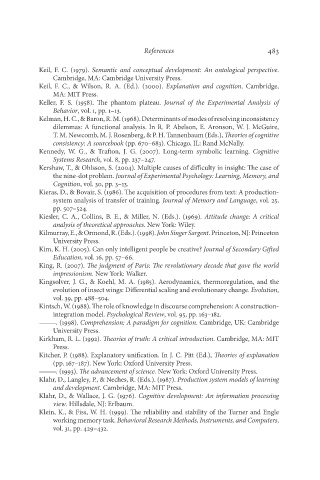Page 500 - Deep Learning
P. 500
References 483
Keil, F. C. (1979). Semantic and conceptual development: An ontological perspective.
Cambridge, MA: Cambridge University Press.
Keil, F. C., & Wilson, R. A. (Ed.). (2000). Explanation and cognition. Cambridge,
MA: MIT Press.
Keller, F. S. (1958). The phantom plateau. Journal of the Experimental Analysis of
Behavior, vol. 1, pp. 1–13.
Kelman, H. C., & Baron, R. M. (1968). Determinants of modes of resolving inconsistency
dilemmas: A functional analysis. In R. P. Abelson, E. Aronson, W. J. McGuire,
T. M. Newcomb, M. J. Rosenberg, & P. H. Tannenbaum (Eds.), Theories of cognitive
consistency: A sourcebook (pp. 670–683). Chicago, IL: Rand McNally.
Kennedy, W. G., & Trafton, J. G. (2007). Long-term symbolic learning. Cognitive
Systems Research, vol. 8, pp. 237–247.
Kershaw, T., & Ohlsson, S. (2004). Multiple causes of difficulty in insight: The case of
the nine-dot problem. Journal of Experimental Psychology: Learning, Memory, and
Cognition, vol. 30, pp. 3–13.
Kieras, D., & Bovair, S. (1986). The acquisition of procedures from text: A production-
system analysis of transfer of training. Journal of Memory and Language, vol. 25,
pp. 507–524.
Kiesler, C. A., Collins, B. E., & Miller, N. (Eds.). (1969). Attitude change: A critical
analysis of theoretical approaches. New York: Wiley.
Kilmurray, E., & Ormond, R. (Eds.). (1998). John Singer Sargent. Princeton, NJ: Princeton
University Press.
Kim, K. H. (2005). Can only intelligent people be creative? Journal of Secondary Gifted
Education, vol. 16, pp. 57–66.
King, R. (2007). The judgment of Paris: The revolutionary decade that gave the world
impressionism. New York: Walker.
Kingsolver, J. G., & Koehl, M. A. (1985). Aerodynamics, thermoregulation, and the
evolution of insect wings: Differential scaling and evolutionary change. Evolution,
vol. 39, pp. 488–504.
Kintsch, W. (1988). The role of knowledge in discourse comprehension: A construction-
integration model. Psychological Review, vol. 95, pp. 163–182.
———. (1998). Comprehension: A paradigm for cognition. Cambridge, UK: Cambridge
University Press.
Kirkham, R. L. (1992). Theories of truth: A critical introduction. Cambridge, MA: MIT
Press.
Kitcher, P. (1988). Explanatory unification. In J. C. Pitt (Ed.), Theories of explanation
(pp. 167–187). New York: Oxford University Press.
———. (1993). The advancement of science. New York: Oxford University Press.
Klahr, D., Langley, P., & Neches, R. (Eds.). (1987). Production system models of learning
and development. Cambridge, MA: MIT Press.
Klahr, D., & Wallace, J. G. (1976). Cognitive development: An information processing
view. Hillsdale, NJ: Erlbaum.
Klein, K., & Fiss, W. H. (1999). The reliability and stability of the Turner and Engle
working memory task. Behavioral Research Methods, Instruments, and Computers,
vol. 31, pp. 429–432.

